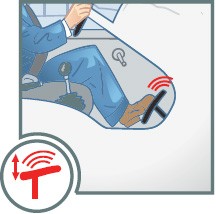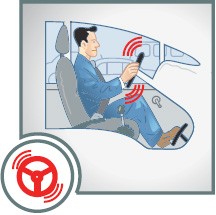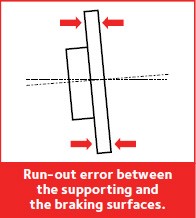Brake judder is the vibration felt through the steering wheel and suspension when the brakes are applied at certain speeds and pressures. It can vary from a barely noticeable vibration to a violent judder – experienced either through the brake pedal or steering wheel.


CAUSES AND SOLUTIONS
CAUSE 1: HUB AND/OR DISC RUN-OUT

Brake judder can be caused by a badly fitted brake disc pulling out of alignment with the hub or caliper. To help you identify if this is the case, here are some symptoms and solutions:
Check for rust or dirt on the wheel hub surface
WHY? Rust or dirt causes poor contact between the disc and hub.
THE SOLUTION: Dismantle the disc and clean both surfaces to remove rust and other pollutants.
Check whether the hub contact surface has been distorted by excessive tightening torque
WHY? Using overly severe tightening torque on the positioning screw leads to vibrations throughout brake application.
THE SOLUTION: Replace the discs, avoiding excessive tightening torque.
Check for distortion of the hub itself
WHY? Although rare, it’s possible for hubs to warp. Bolting a disc to a warped hub will always result in brake vibration. The same will happen if any rust from the hub surface is not removed before fitting the disc.
THE SOLUTION: After fitting a disc, always check for disc run-out using a dial gauge. If the run-out is out of tolerance, re-fit the disc in an alternative position until the run-out is within tolerance. If run-out still remains out of tolerance, hub maintenance is required.
Check whether the alloy wheels have been fitted correctly
WHY? A common cause of disc run-out in recent years is the incorrect fitment of ‘one-size-fits-all’ alloy wheels. As the same wheel is used for multiple hub types and sizes, installers are using location spacers on the wheel spigots. If the spacer is lost or damaged, the wheel cannot be correctly centered.
THE SOLUTION: Place the run-out gauge on the back of the disc while fitting the wheel, and measure the run-out. The gauge will only show run-out once the wheel is fitted and tightened, and it may be necessary to change the wheel.
CAUSE 2: SEVERE DISC OVERHEATING & DISTORTION
Any severe temperature increase can cause the disc metal to distort in different areas of the disc. These ‘hot spots’ cause intermittent contact between the pad and disc. And that results in judder. To help you identify if this is the case, here are some symptoms and solutions:
Check for any signs of brake abuse
WHY? Brake abuse is the most common reason for overheating. Discs are designed to cool rapidly between brake applications. But when the brakes are applied intensely in quick succession – e.g. during alpine driving – the discs don’t get enough time to dissipate the heat.
THE SOLUTION: Blue spots on the disc surface are a good indication of overheating. Discs that show blue spots and/or a darker color in some areas cannot recover and should ALWAYS be replaced, together with the brake pads.
Check the quality of the brake pads
WHY? Poor quality brake pads can overheat very easily, especially during heavy braking. The excessive heat from the pads can cause the discs to overheat, resulting in disc warping.
THE SOLUTION: Again, look for blue spots on the disc surface. When you can't find any, inform the driver of the risks of poor quality pads. ALWAYS replace the brake pads and discs when you do see blue spots on the disc.
CAUSE 3: DISC THICKNESS VARIATION (DTV)
DTV is the variation in thickness around the disc surface. For effective braking, the disc should have the same thickness throughout. If there is an uneven friction surface, the brake pad loses and regains contact with the disc as it turns. And that’s what causes brake judder. To help you identify if this is the case, here are some symptoms and solutions:
Check with the driver to see if the brakes have been properly bedded in
WHY? To get the best performance from your brakes, it’s essential to follow the bedding-in procedure. By applying only moderate pressure on the brake pedal during the first few applications, an even layer of friction material is transferred from the pads to the disc. Mating the surfaces this way improves safety and prevents DTV-related judder.
THE SOLUTION: Prevention is better than cure. Each time you fit new brake pads, or have them fitted, avoid hard braking for the first 200 km (125 miles). When poor bedding-in has resulted in slight DTV, it may be sufficient to bed in the brakes once again. If this does not re-align the disc surfaces, the only solution is to replace both the brake pads and discs.
Check for caliper seizure
WHY? A seized caliper piston, or a seized caliper sliding pin leads to uneven forces being applied to each side of the brake disc, creating uneven wear – or DTV.
THE SOLUTION: This problem is usually caused by corrosion or dirt. Therefore, run the proper maintenance of the seized caliper to prevent the problem from recurring, and replace both the brake pads and discs.
Check for dirt or corrosion on the disc surface
WHY? During braking, some of the brake pad’s friction material transfers to the disc. But with poorer quality brake pads, the deposits of friction material can stick to the disc unevenly, changing the disc’s thickness and parallelism.
THE SOLUTION: If there’s only minimal DTV, it may be sufficient to remove the deposits using a brush or sandpaper and road test the brakes. If this has not re-aligned the surfaces, the only solution is to replace the pads and discs.
Check for pad imprints on the discs
WHY? Holding the brake pedal depressed when the brakes are overheated may imprint or weld pad material on to the discs. The DTV will often be visible as the outline of a brake pad on the disc surface.
THE SOLUTION: It should normally be sufficient to remove the pad imprint using a brush or sandpaper.